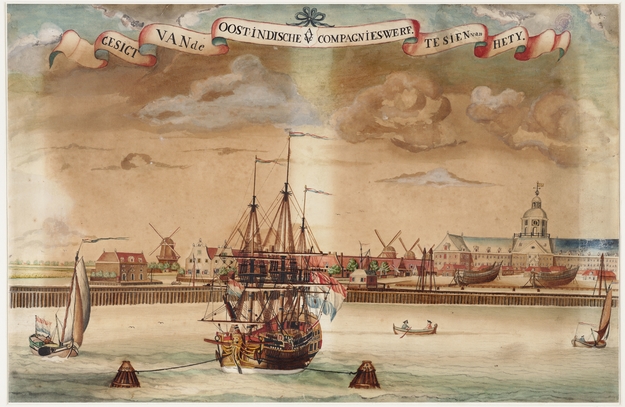In a perfume, the middle and the base note form the main theme of a perfume. This is also the case for the Oosterdok, the main themes are the water surrounding Amsterdam and the industrial impact of the activities of the VOC. The islands, especially Oostenburg and Wittenburg, were associated with the VOC which is the focus of the middle note. Wittenburg and Oostenburg were built for VOC industry, and the islands were also inhabited by people employed by the VOC.
Oostenburg and Wittenburg had a distinct character as compared to other areas in Amsterdam; there were many sub-cultures based on religion and social status of the inhabitants. A lot of small houses were built in a way and on a location that was in accordance with the social class of the labourers. Specifically, Oostenburg was the island where the VOC-associated working class were situated. The island was divided in 178 estates, and by the end of the 18th century, more than 300 houses were built. It is striking that in these living areas, no division existed between the life at home and the life at work. The houses were linked to either warehouses or yards. Here, the somehow-palpable scent of moisture from the surrounding salt water mixed with the smells of the VOC: for example, spices, (dried or salted) meat and fish, pyropneumatic (with a hint of smoke of fire), smells like tar and coal, ropes, wood, textile. The area also included the scents linked to maritime activities, international trade, and the settlements of the early modern sea-faring communities. But how can we re-imagine the smells of this industrious area in lieu of a modern day perfume? To get an idea of this, we look at the kinds of warehouses or other forms of industry that were located on Oostenburg and Wittenburg.
One answer regarding Oosternburg's scent can be drawn from a historical drawing of the VOC Company yard around 1750, as seen from above. The house, drawn on the left, is the tarhouse which we can image had a very intrusive industrial smell. On the right, we see an authoritative white building capped by a bright blue roof, which has been identified as the ‘Oost-Indisch Zeemagazijn’: a warehouse for the VOC. Take a closer look at the ware house with the help of another print from 1710, and we see four sheds on the forefront of the warehouse compound. The warehouse itself was utilised to stow a plethora of items: from aromatic spices such as black pepper and cinnamon, to the ropes and wood that make up VOC ships. These items in itself would have created an interesting scent, but to make matters more interesting, the compound also included a slaughterhouse, which can be seen as on the far left of the four sheds depicted. Not to mention, a big blacksmith’s shop with as much as eighteen fires was located behind the warehouse, though it is not depicted in the 1710 print.
As for Wittenburg, the land was not as easily sold in comparison. There was a brewery, De Parel, as well as a few storage facilities. The city decided to make a part of Wittenburg into a bleaching field where people could wash their clothes. An extraordinary fact is that people used urine to bleach and wash their clothes in the 17th and 18th century. One can only imagine what kind of stench this bleaching field would have generated. Another type of activity existed by the late 18th century in the area was a glass-blowing factory as well as a blacksmith shop. Each of them would have contributed to this nebulous industrious smell.
On the other hand, contemporary literature of the VOC betray sweeter-smelling treats. Naturally, this is expected of a more formal medium, since the VOC was a source of pride and wealth for the Dutch Republic and trade was often praised. To name two examples, the Dutch poet and playwright Joost van den Vondel mentions the storage of the VOC is his poem written in 1655:
"Het rijcke Ostindisch huis verslaeft zich, mat en moe,
En rieckt ons met den geur van 't kruidigh Oosten toe."
The rich East-Indies house, brings us the fragrant spices from the East. This is a great indication of type of scents that accompanies VOC activities. Another mention of the pleasant and aromatic fragrance that the 'East-Indies House' brings to the urban landscape is in the late 17th-century poem by Joannes Antonides van der Goes, Ystroom. In this poem he walks by the IJ, and brings an ode to this very river. He also passes the East-Indies house and writes:
“Van Tidor en Ternate, en wat gewenschter lucht
In 't zwangere oosten teelt, wat keel dien oogst van schatten
Verslint? wat pakhuis die kan in zijn armen vatten?
Zoo dra zy hoort in haer geambert bed, hoe 't Y
Zijn traege baren drijft 't Oostindischhuis voorby,”
This poem sheds light on some sensorial experiences about the area. And since it is an ode to the IJ, it mostly mentioned the positives, such as "the pleasant air of the East". Thus, in comparison, our perfume probably paints a more nuanced picture that involved both the sweet and the foul.

